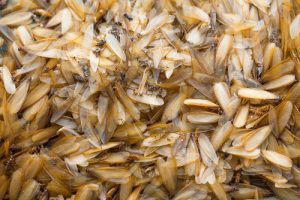Are Termite Swarms Disappearing?
By Chris Williams on March 15, 2012.
Early spring used to be a busy time for pest control companies that do termite control. That’s when termites would swarm and customers would call. Today, any pest control company in the Northeast will tell you that the number of calls they get about swarming termites is way down in the last few years.
Termite swarming is normally triggered by a combination of heat, light, and moisture, and typically occurs on a warm spring day, usually after rain. Outdoors, swarmers emerge directly from their colony in the ground or from infested wood. Indoors, they emerge from mud swarming tubes (which may be hidden inside walls) or from any tiny opening that they can find.
 Termite swarms are usually the first indicator of a termite problem. Termite damage is usually hidden, but the sight of hundreds or thousands of winged termites taking flight or bumbling around inside your home can’t be easily overlooked. The swarms that do occur these days are very small in comparison to previous years. Where a typical swarm used to be made up of thousands of termites, pest control professionals now say it’s unusual to see even a hundred termites in a swarm.
Termite swarms are usually the first indicator of a termite problem. Termite damage is usually hidden, but the sight of hundreds or thousands of winged termites taking flight or bumbling around inside your home can’t be easily overlooked. The swarms that do occur these days are very small in comparison to previous years. Where a typical swarm used to be made up of thousands of termites, pest control professionals now say it’s unusual to see even a hundred termites in a swarm.
Experts give many possible reasons for the reduction in swarming of the eastern subterranean termite, our main termite. Some see it as an indicator of reduced termite numbers overall. Others say that the reduced swarming doesn’t seem to mean an actual decrease in the numbers of termites or colony size, just a difference in their habits. Optimists say it points to improved termite control. Some experts see the reduced swarming of termites as simply reflective of an independent factor, such as climate change, that has caused termites to swarm less often. Perhaps the unusual weather over the past 5 years, with flooding and droughts seemingly far more common and widespread, has depressed the termites’ triggers for swarming.
Whatever the reason, it is clear that eastern subterranean termite swarms have been below average in the last 5 years. Western subterranean termites and Formosan termites have not exhibited a similar long-term reduction in swarms, to date. But all termites will occasionally have a low swarm season in some region at some time. Reduced swarms may only be a temporary condition reflecting a natural low point in termite numbers. In time, termite swarms will either return to normal or entomologists will figure out why they don’t.
Since termite swarms are no longer a reliable predictor of whether or not there is a termite problem, it’s even more important to have your home inspected. If you suspect that you have termites, it’s not a good idea to wait until you see a swarm anyway since swarms typically don’t first occur until the colony is several years old. Give Colonial a call today. Our trained termite technicians can inspect your home for evidence of termites and provide you with peace of mind.